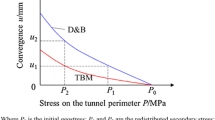Abstract
The influence of the stress state on the evolution of suffusion failure is often neglected in the design of sandy gravel foundations containing a partially penetrating cut-off wall. A series of hydro-mechanical coupling experiments on such structures was carried out to investigate the influence using a newly designed apparatus. The results indicate that: (1) The stress state has a significant influence on the evolution of suffusion, which increases the critical suffusion hydraulic gradient dramatically. (2) The critical suffusion hydraulic gradient is linearly related to the confining pressure and to the penetration ratio, and a simple interpolation function for the critical hydraulic gradient was fitted based on the experimental results. (3) The eroded mass in the development of suffusion is nonuniform and intermittent. The evolution of suffusion is a complicated and iterative process involving fine particle migration, pores being clogged, flushing out of the clogged pores, and fine particle remigration. (4) Flow along the interface of sandy gravel and cut-off wall conforms to the piecewise-linear Darcy flow rule. The results will enhance the understanding of the influence of the stress state on the suffusion failure in sandy gravel foundations containing partially penetrating cut-off walls.












Similar content being viewed by others
References
Asaoka A, Kodaka T (1992) Seepage failure experiments and their analyses of loose and medium dense sands. Soils Found 32(3):117–129
Benmebarek N, Benmebarek S, Kastner R (2005) Numerical studies of seepage failure of sand within a cofferdam. Comput Geotech 32(4):264–273
Harza LF (1935) Uplift and seepage under dams on sand. Trans of ASCE 100(1):1352–1385
Marsland A (1953) Model experiments to study the influence of seepage on the stability of a sheeted excavation in sand. Geotechnique 3(6):223–241
McNamee J (1949) Seepage into a sheeted excavation. Geotechnique 1(4):229–241
Rice JD, Duncan JM (2008) A study on the long-term performance of seepage barriers in dams. Virginia Tech Center for Geotechnical Practice and Research Publication No. 49
Rice JD, Duncan JM (2010a) Findings of case histories on the long-term performance of seepage barriers in dams. J Geotech Geoenviron Eng 136(1):2–15
Rice JD, Duncan JM (2010b) Deformation and cracking of seepage barriers in dams due to changes in the pore pressure regime. J Geotech Geoenviron Eng 136(1):16–25
Skempton AW, Brogan JM (1994) Experiments on piping in sandy gravels. Geotechnique 44(3):449–460
Stephens I (2009) The behavior of flow through cracks in concrete seepage barriers. Utah State University, Logan
Tanaka T, Verruijt A (1999) Seepage failure of sand behind sheet piles-the mechanism and practical approach to analyze. Soils Found 39(3):27–35
Terzaghi K (1943) Theoretical soil mechanics. Wiley, New York, pp 257–261
Van Leuven RG, Rice JD (2011) Assessing the potential for seepage barrier defects to propagate into seepage erosion mechanisms. 31st annual USSD conference: 21st century dam design—advances and adaptations, San Diego, California
Whitmer J (2009) Interaction of soil and seepage barrier cracks under seepage flow. Utah State University, Logan
Wudtke RB (2008) Failure mechanisms of hydraulic heave at excavation. 19th European young geotechnical engineers’ conference, Gyor, Hungary
Acknowledgments
The supports of Natural Science Foundation of China under project No. 51009053, Research Fund for the Doctoral Program of Higher Education of China (20100094120004) and the Special Funds of China Central Colleges Basic Scientific Research Operating Expenses (No. 2009B01914) are gratefully acknowledged.
Author information
Authors and Affiliations
Corresponding author
Rights and permissions
About this article
Cite this article
Luo, Yl., Wu, Q., Zhan, Ml. et al. Hydro-mechanical coupling experiments on suffusion in sandy gravel foundations containing a partially penetrating cut-off wall. Nat Hazards 67, 659–674 (2013). https://doi.org/10.1007/s11069-013-0596-z
Received:
Accepted:
Published:
Issue Date:
DOI: https://doi.org/10.1007/s11069-013-0596-z




